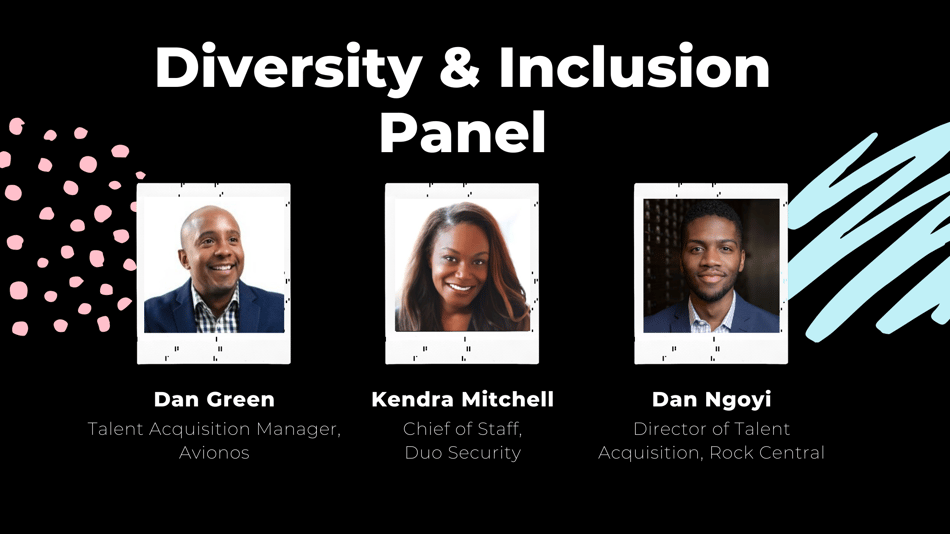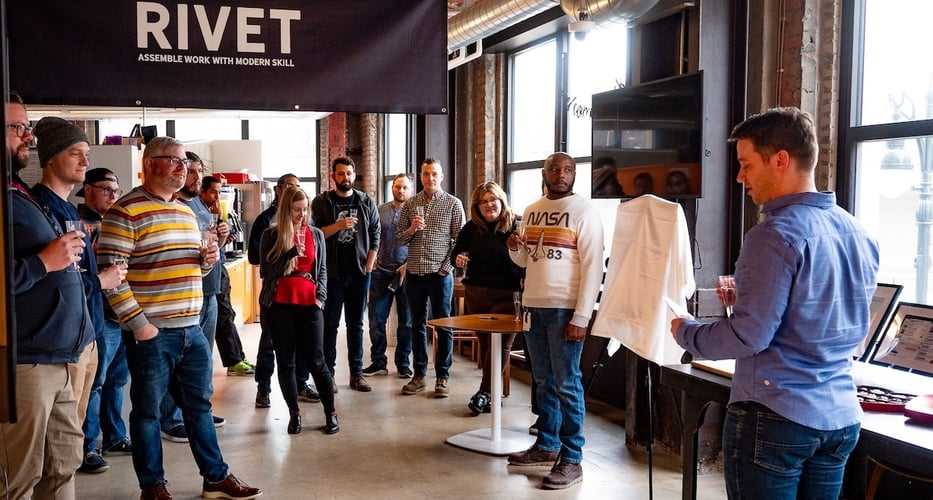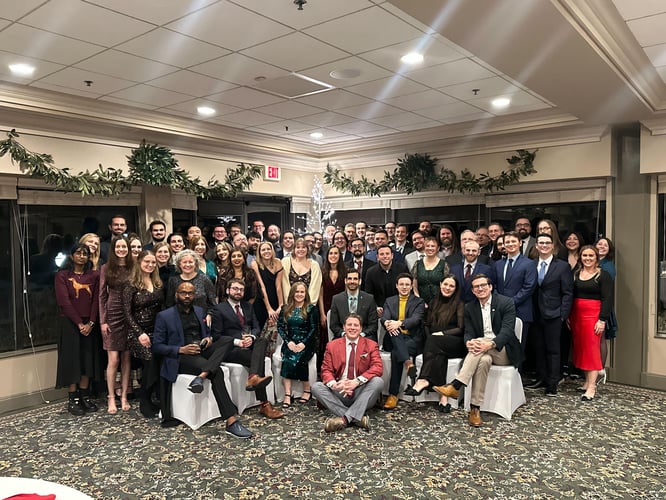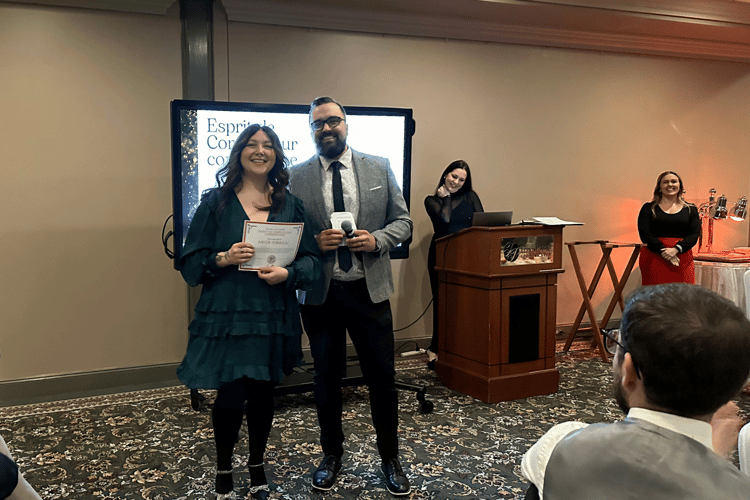On June 23rd, purpose.jobs and DVP hosted a virtual panel discussion on diversity and inclusion. We had nearly 200 people join us on Zoom from various parts of the country and even around the world.
Missed the panel? We’re recapping all the good stuff we learned from this important conversation. Check it out.
Panelists:
Kendra Mitchell, Chief of Staff at Duo Security at Cisco - Prior to becoming Chief of Staff of Duo Security in March of 2019, Kendra held a leadership position on Duo’s legal team. As Assistant General Counsel, Kendra worked on every aspect of Duo’s Operations—privacy, security, compliance, employee relations. Before coming to Duo, she was General Counsel at HITLAB, a healthcare innovation and technology company that examines the way we can leverage technology to improve healthcare outcomes worldwide. She also worked at Sidley Austin law firm (where Barack and Michelle Obama met) and is a proud graduate of Hampton University, an HBCU, as well as Harvard Law School.
Dan Ngoyi, Director of Talent Acquisition at Rock Central - Dan began with Quicken Loans before transition to Rock Central, one of the newest Rock Family startups. His journey with Diversity and Inclusion started 4 years ago when they were a “ragtag group of folks” trying to figure it all out. When he started with Quicken Loans in 2013, they were about 4,000 people. Now they’re about 25,000 people strong. Dan calls it a “journey that’s constantly growing and evolving.”
Dan Green, Talent Acquisition Manager at Avionos - Dan has been in talent acquisition and recruiting throughout his whole career. Got into the diversity and inclusion space when he started focusing on women in tech specifically. He really found his passion in this work—helping underrepresented groups help find a voice. Ever since he’s always made a conscious effort to help the companies he was working at develop diversity and inclusion initiatives and strategies.
Let’s talk about June...
There’s been so much going on the past couple months, but the panelists really centered this conversation around the month of June. As the COVID-19 pandemic rages on, we witnessed the largest civil rights demonstration happening globally play out in cities across the world following the unjust killings of Ahmaud Arbery, Breonna Taylor, George Floyd, Rayshard Brooks, and too many others to name. These events, Kendra said, highlighted the structural reality of racism as it pertains not just to policing and mass incarceration but also to healthcare, education, and housing. All of this happening too, during Pride Month, another movement tied historically to racial justice.
“I don’t want us to not capitalize on this moment of racial reckoning,” Kendra said. “It’s important for us to have these conversations that we’re having right now. But I don’t want us to get stuck in rhetoric or not have the capacity to move from prose to power. I’m really interested in what sort of societal systemic change can happen. For example, what might it look like to create and manifest just cities? How might we reallocate funds for education, mental health, affordable housing, etc.? While we think about the inequality that exists outside of our doorsteps, for those of us in corporate America, I’d really like to think about what it means to build just companies that are centered on belonging, inclusion and equity.”
Dan N. agreed that we’re at a “unique place” when we consider the pandemic and the climate of things going on in our country as a whole.” But if you had told him we’d be having these kinds of conversations so openly in the workplace, he might not have believed you.
“What you’ve seen as a result is a groundswell of awareness that has helped pique curiosity or feed it. Obviously I’d like racism to end. I’d like there to be some magic fairy dust and poof it’s all gone, but that’s not realistic,” Dan N. said. “I really see it as a journey that starts with curiosity then moves into awareness, then education, then growth and sustainability, all underpinned by empathy. I think empathy is such an important piece of it which is why these conversations are so important.”
Dan G. said society has a real opportunity here: “We’re at a point where these things have shined a light on our institutions that are supposed to protect us, but we’re seeing a breakdown in that. We have an opportunity in society to really look at each thing that makes up our institutions.”
Dan G. also reminded us that race is an invention that has stuck with us.
“This idea of race is really baked into everything our institutions are supposed to be working on, protect, or promote. Until we have an opportunity as a society to look at race and try to figure out why these things are so baked into our everyday lives, I’d like us to delve into each of these particular issues and give them the respect that each of them deserves on their own. If you look at the institutions, there are so many different aspects to them. We have to break that up and look at it individually—race, gender, LGBTQ+, etc.,” Dan G. said.
But how do we do that? Our panelists had some really good ideas.
How Companies Can Create Change For the Long Term
Reconcile your stated values with your practices
When looking at your own company, it’s really important to baseline where you are in respect to inclusive practices and behaviors. It’s about looking at your values in action. If there’s a discrepancy between your stated values and your employees' lived experiences, Kendra suggested you reconsider that and build an action plan.
Co-create a plan
Diversity and inclusion can’t be affected by one person or team. It’s not going to successfully drive results across the business. Kendra encourages people to co-create a plan and design it with their leaders and teams so that there’s a sense of buy-in and agency as you create a more holistic view of what your company needs.
Dan N. shared some ideas from the 6-point strategic plan that Quicken Loans and Rock Central put together. It’s meant to drive real, tangible action and was a collective effort of the leadership team across the board. Here are some of the things they are focused on:
-Recruiting
-Team member engagement
-Leadership development
-Government affairs
-Law enforcement engagement
-Communication plans both internally and externally
Set goals and commit to them
Attack these issues the same way you would attack your business plan. Set annual goals, think about how you want to reach them on a quarter by quarter basis, and hold yourself accountable through metrics and other objectives.
“There has to be measures put in place to ensure permanence,” Dan G. said. “It’s very easy to care about Black people or people of color when things are going well. Many companies made Juneteenth a company holiday. But what about next year? Will they have June 19th off? Or does that kind of stuff only happen when a Black person is unjustly killed. In that vein, if you’re looking to set up a better system internally, make sure you have some measure of permanence or metrics that can track progress.”
Dan N. reiterated that sustainability is key: “It’s really easy to be distracted by the shiny objects and one-time actions that feel good and earn a pat on the back,” he said. “But it’s really about being consistent, setting up measures and making sure it’s sustainable over time.”
Hire diverse candidates
“In tech, we love to pat ourselves on the back about how inclusive our cultures are, how much we value diversity, how fair our hiring practices are, but really, it’s not that fair,” Kendra said. “In part, it’s because systemically access to opportunities are not allocated equally across race, gender, socioeconomic status, etc. So if you know there’s this litany of inequities that your candidates face before they even get to your doorstep, then I think it behooves you to think about ways you can go back and sort of dismantle some of that.”
One thing Kendra suggests is looking at coding boot camps for talent. There might be people there who couldn’t afford college, and you tend to see more racial diversity in that range.
“We need to distance ourselves from the idea that we’re a meritocracy. We’re not. In reality, we’re hiring those who have historically had access to opportunities and access to opportunities are not equitably distributed. I’d encourage people to start focusing more on competency-based hiring, not just for candidates from diverse backgrounds but for all candidates,” Kendra said. “Be committed to a growth perspective or framework, allowing all employees to develop and grow in their roles and I think we’ll all be the better for it.”
Think about diversity and equity throughout the employee life cycle
A lot of people are talking about building a diverse, robust talent pipeline, but then what happens once you hire them? As Chief of Staff, Kendra has been thinking about this important question: “How do you support, retain, develop, promote these folks in a way that’s equitable and also encourages a feeling of belonging?”
When Kendra was chatting with some of Duo’s Black engineers and asking them what could be done for Black folks in tech, one of them said, “Just make us feel okay to be our authentic, unapologetically Black selves would really help.”
This is so important, Kendra said. “It’s about bringing everyone to the table in a way that respects their beliefs and values.”
“And once you have folks in your organization, they need to be put up for promotion and leadership roles where they can grow and develop into it. And I think that will yield greater benefit for underrepresented minorities who are often told, 'No,' they can’t have access to an opportunity because they lack the experience. I think that happens to women a lot, too. It shuts them out of leadership, and I’m really passionate about diversity in leadership,” Kendra added.
Dan N. helped frame it for us: “Diversity is the specific traits identifying defining groups. Inclusion is about your ability to accept, welcome and provide access and belonging for everybody,” he said. Then he goes on to share his great Jonas Brothers concert analogy for us: “Diversity is about inviting people to the concert, but inclusion is making sure everyone has access to and space on the dance floor.”
Money is nice, but it’s not sufficient
If you can’t write a large check, that’s okay. Kendra shared that Cisco donated $5 million to a number of organizations including Black Lives Matter. Duo didn’t have that much to donate, but between team members and founders, they raised $300,000. “That felt good,” Kendra said. “Give what you can. Don’t hold yourself to other people’s standards.” For many smaller startups, even $300,000 is out of the question. Give what you can and take action in other ways.
“Not everyone can do a million things,” Dan N. added. “Dig deep and look at where you as an individual and your organization have strengths or relationships you can leverage, and go deep on that, commit to them for an extended period of time because that’s how you can start to drive sustainable change.”
Figure out systemic ways to engage your community
Another way to get involved is to look at your local nonprofits that are working on inclusive entrepreneurship, educating folks in tech, or other initiatives. Partner with these groups, volunteer, collaborate. This can help begin to break down systemic barriers and affect real change.
#keepthatsameenergy
Dan N. gave us a great mantra: Keep That Same Energy. He said, “We have to be focused on sustainable change, not just while the news cycle is in your face. Part of that is being able to acknowledge internally that this is exhausting work that will continue far beyond the quarter or six-month period of time. So there has to be real commitment.”
How Can Candidates Identify Diverse and Inclusive Companies?
Look at their values
Most companies have their values on their website. Dan N. suggests you take the time to look through them and see how fleshed out they are. Also spend some time looking at their social media. Think about this same concept of keeping up the same energy, you’ll see spikes. Social media matters more than ever now, so look at how committed they are. Also check out employee reviews on Glassdoor and LinkedIn.
Look at the leadership team
“Employers can show you better than they can tell you,” Kendra added. As corporations make changes to their language with racist undertones, that’s great, but as Kendra said, “Show me your C-suite. Let me see your board.”
Look at their leadership team. Is their executive leadership diverse? If so, that will tell you a lot.
Make sure you ask the tough questions
Job descriptions only tell you so much. Ask them upfront where they stand on diversity and inclusion so you can see where they are in this process. Are they just starting? Have they created a plan? Even if they are just starting, it’s important that they’re thinking about it and committing to change. “Be honest, open, blunt. Most interviewers appreciate that. Because the interviewer is of course looking at candidates on a talent level but also on a people level, too,” Dan G. said.
Other questions candidates should ask:
- If they have employee stories, whose voices are they highlighting and amplifying?
- Ask about their D&I plans, get really specific there about what they’re doing to foster equitable practices throughout the employee life cycle.
- Ask about their commitment to community engagement and social impact.
Kendra also warns candidates to be deeply suspicious of anyone who talks about culture fit.
“Culture fit is a reinforcer of homogeneity and bias. At Duo, we think of cultural contributions in light of culture being something that’s living and breathing and becoming richer and more nuanced and complex as we all contribute to it and make it better and grow from it,” Kendra said.
Educate yourself
-Read - Kendra suggest Daisy Auger-Dominguez and Aubrey Blanche. You can also check out "Anti-Racist Actions Every Startup Founder Can Take Right Now"
-Listen
-Have conversations with people unlike you
-Get out there - join meetup groups, panels, marches, protests, engage with others, especially others who aren’t like you.
Dan N. suggests you approach it from a space of learning and ask yourself, “How can I challenge my current thought process? What will help me see things in a different light?”
As Dan N. said in the beginning, this is exhausting work. So Dan G. offers this advice:
“Don’t let diversity fatigue win. If we’re going to do something this year, let’s make sure we continue to do it. When all of this dies down, when COVID goes away, when protests die down, continue the conversation, keep poking and prodding, even if it makes you uncomfortable, because at the end of it, there will be a benefit. Not only to yourself but to those you work with.”
#keepthatsameenergy




.png?width=50&name=Erin%20Gregory%20(1).png)

